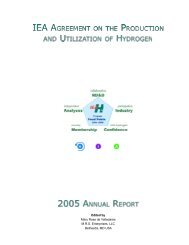Technology Status of Hydrogen Road Vehicles
Technology Status of Hydrogen Road Vehicles
Technology Status of Hydrogen Road Vehicles
Create successful ePaper yourself
Turn your PDF publications into a flip-book with our unique Google optimized e-Paper software.
1.0 Introduction<br />
This report was commissioned under the <strong>Hydrogen</strong> Implementing Agreement <strong>of</strong> the International Energy<br />
Agency (IEA), and examines the state <strong>of</strong> the art in the evolving field <strong>of</strong> hydrogen-fueled vehicles for road<br />
transport. The first phase surveys and analyzes developments since 1989, when a comprehensive review was<br />
last published (DeLuchi 1989). The report emphasizes the following:<br />
! Problems, especially backfiring, with internal combustion engines (ICEs)<br />
! Operational safety<br />
! <strong>Hydrogen</strong> handling and on-board storage<br />
! Ongoing demonstration projects.<br />
<strong>Hydrogen</strong> vehicles are receiving much attention, especially at the research and development level. However,<br />
there has been a steady move during the past 5 years toward integral demonstrations <strong>of</strong> operable vehicles<br />
intended for public roads. Because they emit few, or no greenhouse gases, hydrogen vehicles are beginning<br />
to be taken seriously as a promising solution to the problems <strong>of</strong> urban air quality.<br />
Most information sources for this report are published documents. Some were supplied by IEA and European<br />
Community <strong>of</strong>ficials, but most were accessed from the document retrieval systems in common scientific use.<br />
Several hundred documents were scanned for interest; about 150 were studied for relevance to this report.<br />
Most had some bearing on the way the report is presented, but only the 50 actually quoted or referred to in<br />
the text are listed in the References section. Much work <strong>of</strong> direct relevance is undoubtedly missing, either<br />
because it is too recent or too proprietary. In a fast-moving field <strong>of</strong> some industrial importance, the best<br />
results are kept under wraps until the time is ripe for exploitation. And some relevant published work may<br />
have been overlooked.<br />
The starting point for this study is the comprehensive work <strong>of</strong> DeLuchi (1989). It is rich with the input <strong>of</strong> 165<br />
documents consulted, and should be read in conjunction with this report. In particular it makes a life-cycle<br />
cost comparison among the various technologies, and concluded that even 6 years ago the economics <strong>of</strong> some<br />
hydrogen vehicles was already competitive.<br />
Since the time the first draft <strong>of</strong> this report was prepared (mid-1996), the 11th World <strong>Hydrogen</strong> Energy<br />
Conference took place in Stuttgart, Germany. This biennial conference can be regarded as a valid updating<br />
<strong>of</strong> the state <strong>of</strong> the art; therefore, the 1996 results are included in this current version. Those <strong>of</strong> interest to<br />
hydrogen vehicles are discussed throughout this report, with the most detail included in Appendix 4.<br />
A summary <strong>of</strong> DeLuchi 1989 is also included. For convenience, this is also presented in Appendix 4. As a<br />
consequence <strong>of</strong> this updating, we also became aware <strong>of</strong> a valuable report, not yet available in the public<br />
literature, concerning a comprehensive safety investigation on hydrogen (EQHHPP Nov. 1993). Awaiting its<br />
publication, we can only include a brief summary in Appendix 1 on safety questions.<br />
2.0 <strong>Hydrogen</strong> Production and Distribution to Urban Users<br />
2.1 <strong>Hydrogen</strong> Production and Bulk Transport<br />
<strong>Hydrogen</strong> as a fuel (or more correctly as an energy vector) for any application is inseparable from its basic<br />
rationale: recourse to clean and renewable energy (clearen). The interdependence <strong>of</strong> hydrogen and clearen<br />
is so strong that one can hardly become widespread without the other.<br />
Clearens are all sun-derived on a short cycle, and include photovoltaics, wind, hydropower, and energy crops<br />
1













